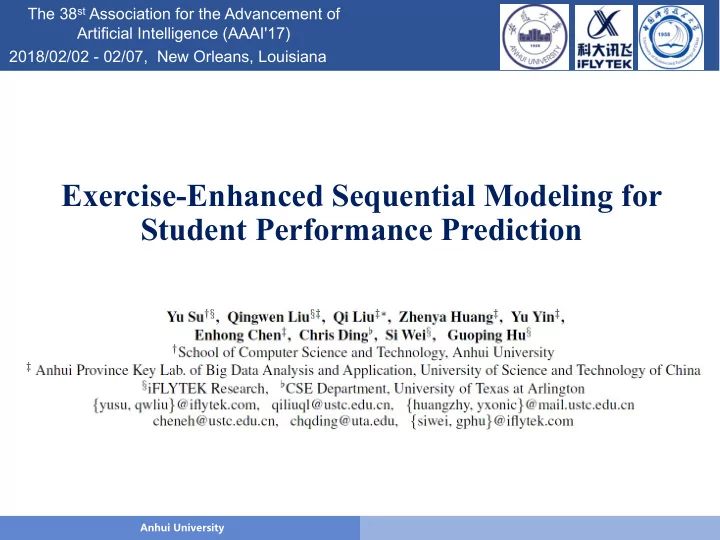

The 38 st Association for the Advancement of Artificial Intelligence (AAAI'17) 2018/02/02 - 02/07, New Orleans, Louisiana Exercise-Enhanced Sequential Modeling for Student Performance Prediction ������ ���������
Outline ����������������������� � ������������������ � ��������������� � ����������� � �������������������������� � ����������������
Background- Online Education System Online education systems provide students with open access for self- learning (e.g., learning remedy suggestion and personalized exercise recommendation). ����������� �������� ���������������� �����!���������
Background- Predict Student Performance How can we say an education system understand a student? ��������� �������������� ��������� ����)��� ���������� ������������ ���(������������� �������� ���������������� ��)�������������
Research Problem l Urgent issue: Predict Student Performance(PSP) l How to automatically predict student performance without manual intervention ? l This work regards score as performance. l Opportunity l Exercises records of students l Text materials of exercise ���������������� �������������� ������������������ ���������������������� ����������������
Challenge 1 for PSP l Diverse expressions of exercises � ����2���������������1�������������1�������� � l Need a unified way to understand and represent them automatically. ���������������2
Challenge 2 for PSP l Long-term historical exercising ��� ! " ! # ! $ ! % ! %&" ������ ���������
Challenge 3 for PSP l Cold start problem ����� ����� �������������� ������������ ������� ���������������� ���������������
Related Work for PSP l Education Psychology IRT (Item Response Theory) l models student exercising records by a logistic-like function l BKT (Bayesian Knowledge Tracing) l traces them with a kind of hidden Markov model l l Machine Learning and Data Mining PMF l projects students and exercises into latent factors l l Deep Learning DKT l deep learning method uses RNN to model student exercising process l for prediction . ������ ���������
Outline ����������������������� � ������������������ � ��������������� � ����������� � �������������������������� � ����������������
Problem Definition • Given: the exercising records of each student and the text descriptions of each exercise from 1 to T � • Goal: train a unified model M, predict the scores on the next exercise ! "#$ of each specific student. ����������������
Outline ����������������������� � ������������������ � ��������������� � ����������� � �������������������������� � ����������������
Exercise-Enhanced Recurrent Neural Network(EERNN) ������ ����� ������ ������ ����������������
Step 1: Word Embedding Goal: learn word representations from semantic perspective in math exercise. l ���������������������� Main procedures: l �������� l Word split l Latex to feature �������� l Word to vector �������� ������ ���������
Step 2: Exercise Embedding • Goal: Exercise Embedding learns the semantic representation of each exercise ! " from its text input # " automatically. ����������� ����� ����������������
Step 3: Student Embedding Goal: Student Embedding aims at modeling the whole student exercising l process and learning the hidden representations of students. Combine the score and embedding % & ��� ! " 0000 … 000000 0000 … 000000 ! " ����������������
Step 4: Prediction (Two Strategies) • Goal: Predicting her performance on exercise ! "#$ at step T +1 . ���� �������������������� ����������������
Step 4: Prediction (Two Strategies) Predicting her score on exercise " #$% is &̃ #$% ��������� � � � � � � � � � � …… � � � � � � � � � � ������������������������������ ����������������
Step 4: Prediction (Two Strategies) Goal: predicting her performance on exercise ! "#$ at step T +1. • ���� ������������������������ ����������������
Outline ����������������������� � ������������������ � ��������������� � ����������� � �������������������������� � ����������������
Experiments l Experiments dataset l Supplied by Zhixue, IFLYTEK l a widely-used online learning system, which provides senior high school students with a large exercise resources for exercising. ������ ���������
Experiments l Baseline methods l Variants of EERNN: LSTMM, LSTMA l just utilize knowledge-specific representations l To validate the importance to incorporate exercise texts for the prediction in EERNN l Education Psychology : IRT, BKT l Machine Learning and Data Mining: PMF l deep learning method: DKT l The most similar method to ours l Evaluation metrics l Regression perspective: RMSE l classification perspective: ACC , AUC ������ ���������
Experiments ������ ���������
Experiments Information can be used by EERNNM More Information can be used by EERNNM Old Information forget by EERNNM Focus useful information by EERNNA ������ ���������
Experiments ���������� ����� ����������������
Outline ����������������������� � ������������������ � ��������������� � ����������� � �������������������������� � ����������������
Conclusion l Proposed a novel EERNN framework to predict student future performance. l EERNN integrated two critical components, BiLSTM to extract exercise semantic representations from texts, LSTM architecture to trace student states. l Proposed two strategies for prediction : EERNNM with Markov property and EERNNA with Attention mechanism. l Experiments on real-world dataset demonstrated the effectiveness (specially cold start problem) of EERNN . ������ ���������
Future Work l Different exercise types (e.g., the subjective exercises with continuous scores) l Incorporate more information l Knowledge concepts l The time cost on exercises l Integrate some educational theories l learning and forgetting curves l Guess and slip ������ ���������
Q & A ������ ���������
Recommend
More recommend